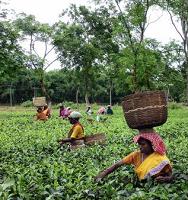
Download After water, tea is the world’s most popular drink.
The highlands of Bangladesh have been producing tea for over 150 years, but the profits at the expense of slave-like conditions for the workers has long been the subject of controversy and conflict.
In this two part series, reporter Ric Wasserman journeys to the plantations in northeast Bangladesh to gain a rare insight into the tea estates.
It’s the midday call on the tea plantation. Gopal’s voice rings out clear over the estate, the same call as it’s been since 1839, when tea was first planted here.
The five hundred tea pluckers at the Srigobindapur estate raise their sacks loaded with the bright green leaves to their heads, and begin walking down the worn dirt path toward the processing plant.
On both sides a green carpet of chest high teabushes stretches out.
They then dump their tea onto a drying unit, and are about to take their first break of the day after five hours working under the sun.
Amina Rao is a fourth generation tea plucker.
”I get up early, make breakfast for my children, grab my tea sack and go off to the tea fields. By noon I’ve picked about 30 kilograms. I’ll pick another 30 kilos before the day is done.”
The Srigobindapur factory, like the other 168 in Bangladesh is basically a series of three large tin-roofed buildings where the tea is dried, finely chopped, lightly fermented and graded.
Russel Alom is a cousin of the owner. Without his help, I would have never gained access to this secretive world of tea making.
Guards are posted here to keep out the photo- journalists who have been writing recently about the miserable working conditions for the tea workers and the master-slave realtionship where generations of families have seldom been off the estate, nor gotten higher education.
The Srigobindapur estate is a small one, where five hundred tea pluckers work four hundred acres, but the profits are huge.
Says Azad Aziz, the assistent manager.
”My production expense per kg is 70tk (80cents/kg) and we are selling the tea for nearly 200 tk.(three dollars/kg). We want to export to other countries but our local consumption is very high.”
At 70 takkas to the dollar, that’s a handsome three hundred percent profit per kilo.
In Bangladesh, one of the world’s poorest countries, there is more money available now for a non-essential, like tea. Local consumption has increased to 70 percent.
But for the tea workers themselves not much has changed since they were first imported by the British from the neighbouring Indian states of Bihar, Assam, and Orissa over 150 years ago.
They were brought here because the locals refused to do the back breaking work, or accept the terribly low wages.
Philip Gain is the director of the Society for Environment and Human Development, in Bangladesh.
”Work in the tea gardens is very monotonous. After planting when they begin to harvest the leaves a lady has to work all the time standing. And then the pay is very little. Right now they get 48 takka.”
That’s 70 US cents per day
By comparison, tea workers in India earn twice as much.
”And these people remain isolated from the local communities. Most of them are Hindus. They are considered Dalits, untouchables. They are subject to economic exploitation, they are subject to social exclusion, so the life in the labour line is really very tough.”
A visit to the Tea Museum in Srimangol confirms what Philip Gain has said.
Among the artifacts is a glass case with a collection of coins, called haziras.
The coins were minted by the estate owners themselves, and served as payment to the workers.
As the coins could only be used on the estate, it ensured the owners that any workers who might try to escape, would have no money to return home or survive outside the confines of their tea garden.
After much haggling over trying to get in with a guard at the gate, I’m finally allowed to meet Syed Alimuzzaman, the Bangladesh CEO of one of the largest tea producers in the world, Finlays.
The company produces 12 million kilograms of tea per year, but Syed Alimuzzaman claims there is little profit.
”Profit in tea is comparatively less. You have to invest a lot of money but outcome is less than 10 percent of the total investment, in addition to capital investment. A very meager amount.”
It’s hard to believe the proft margin at Finlays should only come to a fraction of that at the much smaller Srigobindapur estate.
Regarding the situation for Finlays’ 15,000 tea workers, he believes they should be satisfied.
”Wages are already fixed, there is no problem regarding that. Last year it has gone up by 50 percent. I don’t think they’re getting less wages, as compared to garments and others. In addition they’re getting free housing.”
Three thousand workers converged on the capital in protest in 2008, demanding that 50 percent pay increase Syed is talking about.
They now earn 70 US cents per day for their labour, still the lowest paid job in Bangladesh.
In part two of this series our reporter Ric Wasserman meets the tea estate owners’ enemy number one: labour leader Rambajan Koiri, and gets a rare opportunity to document the lives of the families of the closed village community for the tea workers.












